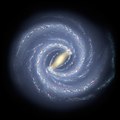Leo V (dwarf galaxy)

| Leo V Dwarf Galaxy[1] | |
|---|---|
| Observation data (J2000 epoch) | |
| Constellation | Leo |
| Right ascension | 11h 31m 9.6s[1] |
| Declination | +02° 13′ 12″[1] |
| Distance | 585 kly (180 kpc)[2] 570 ± 30 kly (175 ± 9 kpc)[3] |
| Apparent magnitude (V) | 16 ± 0.4[3] |
| Characteristics | |
| Type | DSph[2] |
| Apparent size (V) | 5.2 ± 1.2′[3] |
| Other designations | |
| Leo V,[1] PGC 4713563 | |
Leo V is a dwarf spheroidal galaxy situated in the Leo constellation and discovered in 2007 in the data obtained by the Sloan Digital Sky Survey.[2] The galaxy is located at a distance of about 180 kpc from the Sun and moves away from the Sun with the velocity of about 173 km/s.[2] It is classified as a dwarf spheroidal galaxy (dSph) meaning that it has an approximately spherical shape with the half-light radius of about 130 pc.[3][note 1]
Leo V is one of the smallest and faintest satellites of the Milky Way—its integrated luminosity is about 10,000 times that of the Sun (absolute visible magnitude of about −5.2 ± 0.4),[note 1] which is much lower than the luminosity of a typical globular cluster.[3] However, its mass is about 330 thousand solar masses, which means that Leo's V mass to light ratio is around 75. A relatively high mass to light ratio implies that Leo V is dominated by dark matter.[4] The stellar population of Leo V consists mainly of old stars formed more than 12 billion years ago.[2] The metallicity of these stars is also very low at [Fe/H] ≈ −2.0 ± 0.2, which means that they contain 100 times less heavy elements than the Sun.[4]
The galaxy is located only 3 degrees away from another Milky Way satellite, Leo IV. The latter is also closer to the Sun by 20 kpc. These two galaxies may be physically associated with each other.[2] There is evidence that they are connected by a star bridge.[3]
Notes
[edit]References
[edit]- ^ a b c d "NAME Leo V". SIMBAD. Centre de données astronomiques de Strasbourg. Retrieved 2010-02-04.
- ^ a b c d e f g Belokurov, V.; Walker, M. G.; Evans, N. W.; et al. (2008). "Leo V: A companion of a companion of the Milky Way galaxy". The Astrophysical Journal. 686 (2): L83 – L86. arXiv:0807.2831. Bibcode:2008ApJ...686L..83B. doi:10.1086/592962. S2CID 11090182.
- ^ a b c d e f de Jong, J. T. A.; Martin, N. F.; Rix, H. W.; Smith, K. W.; Jin, S.; Macciò, A. V. (2010). "The Enigmatic Pair of Dwarf Galaxies Leo Iv and Leo V: Coincidence or Common Origin?". The Astrophysical Journal. 710 (2): 1664–1671. arXiv:0912.3251. Bibcode:2010ApJ...710.1664D. doi:10.1088/0004-637X/710/2/1664. S2CID 5667891.
- ^ a b Walker, M. G.; Belokurov, V.; Evans, N. W.; et al. (2009). "Leo V: Spectroscopy of a Distant and Disturbed Satellite". The Astrophysical Journal. 694 (2): L144–147. arXiv:0902.3003. Bibcode:2009ApJ...694L.144W. doi:10.1088/0004-637X/694/2/L144. S2CID 6053472.
